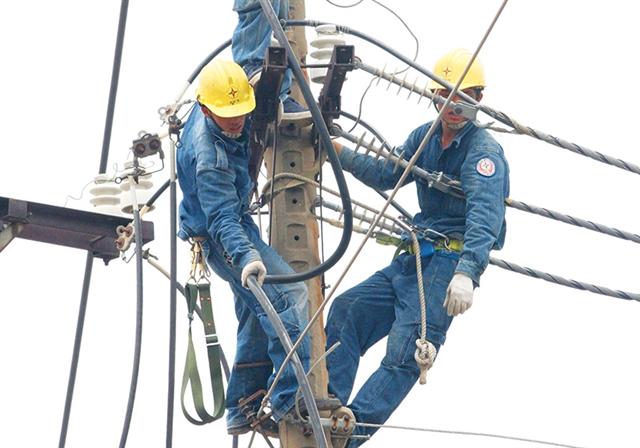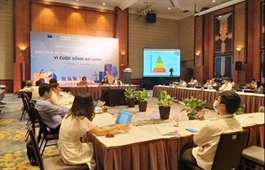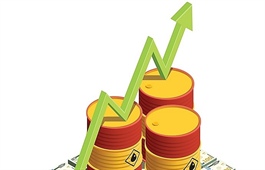Power price proposal on table as equality remains uncertain
Power price proposal on table as equality remains uncertain
Amid feedback from the public and experts about calculating energy price, the Ministry of Industry and Trade has rounded off the single-price model for household electricity in a bid to harmonise the benefits of all stakeholders in society.

As Vietnam’s economic grows rapidly, so does its energy consumption, leading to an annual increase of 9-10 per cent. Photo: Le Toan
|
Potential changes in electricity prices have been causing a storm among the public in the hot summer months as bills for households soared. While the current 6-tier electricity tariff in Vietnam is considered inappropriate, drafts for a new model to calculate household electricity prices by the Ministry of Industry and Trade (MoIT) have seemingly not fully resolved certain issues, especially with an increase in bills being one potential outcome.
Under the draft, instead of calculating costs under a 6-stage model, the draft proposes to re-calculate them with a 5-stage model and an additional single price model. Accordingly, one price for electricity would be based on the average cost of VND1,864.44 ($8.1 US cents) per kilowatt hour, excluding VAT (see box).
The MoIT is offering a plan to apply a parallel 5-tier electricity retail price structure for domestic purposes and one-price retail electricity rate. The idea is a new one never appearing before in previous MoIT drafts.
In Option 2, customers can select either the 5-tier price model or the single-price model. Option 2 embraces two sub-options, namely 2A and 2B opened for comment. Under the 2A single-price model and 2B single-price model, the proposed power prices are 145 and 155 per cent, respectively, higher than the existing average electricity price.
Nguyen Minh Hoa from Hanoi’s Hai Ba Trung district said that there is a need for a price appraisal panel, in order to make a specific price that harmonises both buyers and sellers as well as making it more transparent. Previously state-run Electricity of Vietnam (EVN) admitted that bill recording errors in the local area have occurred.
The public are looking for electricity prices to be transparent and demand benefits from a new model, while the big goal of changing the retail price structure of electricity for household electricity must support poor households, save energy, and ensure profit guarantees and re-investment.
|
Unfeasible model for single electricity price?
At last week’s meeting, MoIT Minister Tran Tuan Anh stressed, “We are setting many goals when building the retail electricity tariff for daily life. In the current context of main sources from non-renewables, high electricity demand, and lack of high technology, the construction and completion of electricity retail tariffs to harmonise all item spending is not easy.”
The MoIT has received over 130 pieces of feedback for their draft thus far. Opinions from the public regard errors in the implementation process, as well as electricity bills soaring in the summer due to a ladder effect that is forcing the ministry leaders to think about new electricity price options.
The idea of a one-price electricity is an attempt to overcome such disadvantages, but there were also many objections to the MoIT’s single price model for household electricity.
Energy expert Bui Xuan Hoi explained that the single price model cannot solve issues around social protection for the poor and energy efficiency policies.
Some raised concerns that when using a one-price electricity tariff, richer people enjoying the same price as the poor will easily abuse electricity, leading to unfair national energy use and conservation.
According to the MoIT, there are more than 1.2 million customers using less than 50 kWh per month. Customers using 50-300kWh per month include over 18 million households, accounting for 72 per cent. The number of customers using over 700kWh per month compared to a 2015 survey has increased significantly, accounting for about 1.7 per cent, with output consumption of about 13 per cent.
Industry insiders said that Ho Chi Minh City asked for a single price model, which could not apply for the whole country because residents there gain benefits from solar rooftops, and weather differences are quite vast compared to other regions.
“We must take all of these factors into account in order to construct the most affordable pricing scheme,” one opinion suggested.
Minister Tuan Anh admitted at the meeting that proposals are inconsistent and difficult to work with. “They are not suitable because it does not encourage electricity savings, and cannot ensure targets to balance enough electricity to serve the country’s development needs and energy security,” he said. “It is not feasible to equate all objects, regardless of whether they are rich or poor. Especially, it makes it difficult for the implementation of social security policies to support the poor and disadvantaged people in society.”
He added that the electricity market is competitive and the state has other tools and forms to support disadvantaged people.
Under a decision released in 2013, the competitive electricity market was to take shape in a three-stage roadmap with a competitive retail market expected by 2021-2023.
Nguyen Tien Thoa, former director of the Ministry of Finance’s Department of Price Management, said that the 5-stage model does not increase the average price, and ensures that about 98.2 per cent of electricity consumers with consumption below 700kWh per month have electricity prices without an increase, and even decreasing price steps.
In the same viewpoint, MoIT Deputy Minister Do Thang Hai emphasised the requirement of sufficient electricity supply and price assurance. “Electricity rates being reasonable and transparent – this is what people care most about,” he said.
According to Hai, in the current situation of electricity shortage, it would not be appropriate to apply single-price electricity, as it does not encourage saving electricity. If a step method is applied, attention should be paid to the calculation so that the distance between the steps is suitable.
Thus, the MoIT scraped the single power price proposal which is considered a wise movement though it can give more options to customers.
Ensuring sufficient supply
Vietnam has experienced a significant increase in energy consumption, especially power consumption, with an annual growth rate of about 9-10 per cent in the past decade. According to the revised National Power Development Plan VII the total national energy consumption, especially fossil fuels, will increase rapidly in the coming period in order to meet the country’s high economic growth.
The Vietnam Business Forum (VBF) in a report suggested the publication of the Roadmap to Retail Electricity Tariffs to 2025 for Vietnam with particular focus on the sectors of commerce and industry. The roadmap must outline the move towards market-based pricing and should specifically address peak loads during business working hours and incorporate a differential retail price across the regions.
To complement the roadmap, the VBF proposed holding a campaign to educate stakeholders about energy efficiency. This would help consumers engage with and understand the energy industry as tariff rates rise.
Keeping up with the rapidly growing demand for power will require bringing a significant amount of additional capacity online. By Electricity of Vietnam’s (EVN) estimates, this upgrade to the power system will require Vietnam to attract more than $150 billion in new capital investment into the country. With the government nearing its designated debt ceiling, questions remain about how Vietnam will manage to spur sufficient levels of capital investment in the power sector and avoid power shortages, especially in the south, where reserve margins are already razor thin.
In a previous talk with VIR, the MoIT said that among the necessary measures, firstly it should attract investment from the private sector into the energy sector. The question remains how the private sector can take a more integral part in power sector financing.























